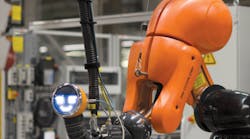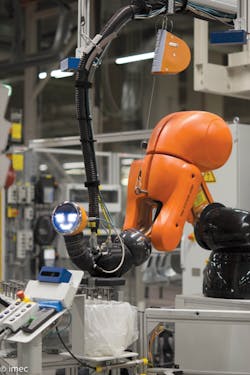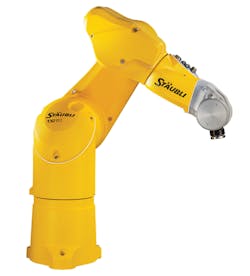They call them cobots for a reason: to distinguish this new tribe of collaborative robots from both the scary robots of sci-fi and the more common industrial robots that generally must operate separate from—or even fenced off from—their human colleagues. It’s an important distinction and one that has special relevance as pundits and the public eye a new wave of automation that some fear could eliminate broad categories of jobs. With cobots, the emphasis is on enhancing worker capabilities through automation.
John Santagate, research manager at analyst firm IDC, said he is seeing significant growth, especially for robots designed to work hand-in-hand with humans and mobile versions that support humans in their work places. Cobots “have more use case options than fixed robots that must work in their own separate space,” he noted. Already they are being applied in light manufacturing tasks and in fulfillment centers or warehouses. He cites Locus Robotics and Aethon’s TUG robot as examples of technologies that allow cobots to operate over a wide area, handling tasks like moving small items from place to place reliably and at a low cost.
Importantly, new guidelines, ISO/TS 15066:2016, were published last year to help ensure that robots and humans can work together safely. Among other things, the guidelines even specify that the robot be designed without edges or surfaces that could hurt a clumsy human inadvertently walking into the robot.
New market approaches
“A lot of companies in the cobot area are focusing on one or two areas, and others offer more of a do-it-yourself approach, said Gerald Van Hoy, senior research analyst at Gartner. Universal Robots (UR), the company that claims to have invented the cobot concept, sold its first unit some eight years ago. Based in Odense, Denmark, the company was acquired by Boston-based automated testing giant Teradyne in 2016 for $285 million. UR claims to be able to “automate anything” and has sold thousands of units so far. The company emphasizes the do-it-yourself opportunity—with claims of simplified programming and setup options.
Others have focused simply on enhancing the manufacturing environment. Recently, imec, Vrije Universiteit Brussel, University of Hasselt, and five industry partners introduced their take on the cobot with Walt, which was developed specifically to work with people. Audi Brussels, one of the project partners, is testing a unit at its production line (Figure 1).
Courtesy of imec
The project has focused on two cobot characteristics. First, in order to have robots work alongside human operators, the robot needed to be made compliant—meaning that it is designed to actuate safely, perhaps through spring-loaded members that can limit the force it applies—and it includes other features that would prevent it from crushing or injuring a person. Any tendency toward inaccuracy in operation caused by this design is, in turn, addressed by new adaptive-control software. Second, researchers studied new approaches for humans to communicate—and exchange knowledge—with cobots. For example, the project included the capability to have a human simply demonstrate a task with the robot promptly learning to duplicate the actions. Conveying information via gestures—a common human-to-human form of communication—also is accomplished in this cobot.
Established players see opportunity
Meanwhile, according to Van Hoy, major robot makers such as ABB are testing the water. One established maker of mechatronic products, Stäubli, based in Pfäffikon, Switzerland, just introduced its new TX2 line of collaborative robots (Figure 2) to the North American market at the Automate trade show in Chicago. The company’s take on cobots builds on a line of more conventional six-axis machines with additional safety controls.
Courtesy of Stäubli
Stäubli defines five stages on the path to man-robot collaboration. Stage 1 is “now” with robots separated from humans. Stages 2 through 4 involve increasing levels of interaction, though robots are still largely separated from people. The final stage, in the company’s view, is stage 5, where there is no separation between the robot and operator. Some of these capabilities are displayed in the company’s TX2 Series robots, which will slow down and stop before the operator approaches and stay in the safe status while the human is in the vicinity—for example, while a person is loading or unloading components. Then when it is safe, the robot will continue operation without requiring any reinitialization process.
Need and momentum
“We spend two out of five business days each week on routine work that is not core to our jobs, using manual tools that are ill-suited to the tasks we need to complete,” noted Michael Hubbard, global vice president at ServiceNow Inspire, a cloud computing company and consultancy. “A McKinsey multiyear study found about 60% of occupations could have 30% or more of their constituent activities automated,” he added.
Because of those kinds of factors, Van Hoy added, the cobot phenomenon is set to grow. “It’s not only that these machines are more nimble and adaptable—it is also that they now require less space, which has immediate money-saving implications,” he said.



